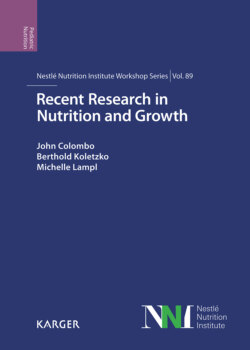Читать книгу Recent Research in Nutrition and Growth - Группа авторов - Страница 39
На сайте Литреса книга снята с продажи.
Delineation of Developmental Windows in Muscle Development
ОглавлениеThree broad windows can be defined for muscle growth (Fig. 1) and, although suboptimal nutrition retards muscle growth at any age, the specific cellular events that are affected at each stage differ. These differences are critical as they dictate whether the muscle can recuperate when adequate nutrition is restored. In the fetal phase when secondary muscle fibers are forming, maternal nutrient restriction results in a reduction in the number of fibers and, even though myofiber size may be recoverable, there is a permanent deficit in muscle mass because additional fibers are not generated once this window is closed [6, 13, 14]. This response is manifested only when there is very severe maternal nutrient restriction [14], and it may be attributable to concurrent maternal stress and nutrient deficits. Nonetheless, the reduction in fiber number in animals in which only nutrient flow to the fetus is disrupted, e.g., due to placental insufficiency, suggests that nutrient deficiency per se can impede myofiber formation [6, 13]. The exact mechanisms responsible for the impairment of this myogenesis step are uncertain. As indicated previously, there is little fiber hypertrophy at this time, and, thus, reduced myoblast proliferation, migration, and/or fusion as well as increased apoptosis are likely responsible. Whether this is also true for humans is uncertain, but there is no evidence to indicate that their response would differ.
The second phase spans the perinatal period to approximately weaning during which time the myonuclear number and protein mass of fibers increase rapidly. The acceleration in muscle hypertrophy over this period incurs a high nutrient cost which, if not met, leads to growth faltering. In species where this phase begins in late gestation, a compromised nutrient supply to the fetus leads to the diversion of blood flow and nutrients to spare the brain and organs at the cost of muscle growth [reviewed in 2]. Similarly, when the postnatal amino acid and energy requirements to support optimal growth are not met, skeletal muscle growth is preferentially blunted. Studies in experimental animal models [reviewed in 15] as well in human cohorts [1, 3] provide strong evidence that deficits in muscle mass incurred during this phase cannot be recuperated entirely. During the third phase, attained once compositional and functional maturation are complete, muscle fiber hypertrophy continues at a slower rate, and any deficits incurred during this final window are recoverable.
The second window of muscle development, i.e., the perinatal phase, is of clinical significance because, if compromised, vital functions necessary for extrauterine survival, such as breathing, feeding, and locomotion, will be affected. For a newborn, breathing and feeding are essential for the transition to extrauterine life, and when their function is suboptimal, there are detrimental short- and long-term morbidities. In animals, the capacity for locomotor function is also critical for survival in the newborn, whereas in humans this function becomes important as the child begins to interact with its environment. In the long term, reduced muscle mass places the individual at increased risk of developing obesity, insulin resistance, and early-onset sarcopenia, and reduces their productivity, quality of life, and longevity [2, 3, 16]. Thus, it is essential that we understand the mechanisms that confer anabolic potential to the newly formed muscle so that we have a thorough understanding of how the nutritional management of neonates during this window of development can be optimized to ensure that muscle growth is not compromised.
Table 1. The postabsorptive and postprandial fractional rates of total protein synthesis, degradation, and accretion, and total RNA (as a measure of ribosomal abundance) in hind limb muscles of well-nourished rats from 6 to 70 days of age
